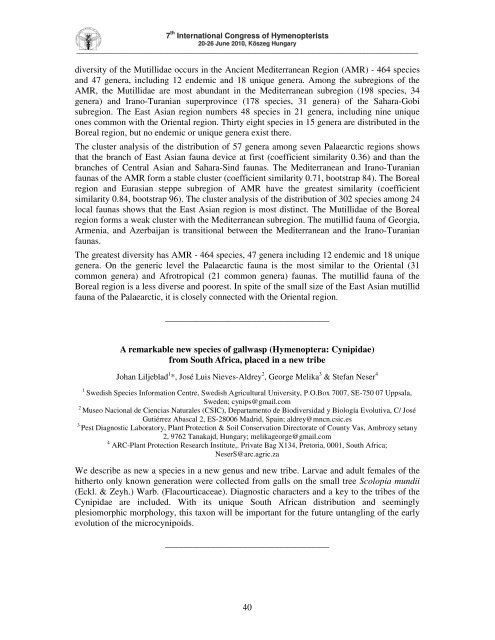Seventh International Congress of Hymenopterists
Seventh International Congress of Hymenopterists
Seventh International Congress of Hymenopterists
You also want an ePaper? Increase the reach of your titles
YUMPU automatically turns print PDFs into web optimized ePapers that Google loves.
7 th <strong>International</strong> <strong>Congress</strong> <strong>of</strong> <strong>Hymenopterists</strong><br />
20-26 June 2010, Kszeg Hungary<br />
_____________________________________________________________________________________________________<br />
diversity <strong>of</strong> the Mutillidae occurs in the Ancient Mediterranean Region (AMR) - 464 species<br />
and 47 genera, including 12 endemic and 18 unique genera. Among the subregions <strong>of</strong> the<br />
AMR, the Mutillidae are most abundant in the Mediterranean subregion (198 species, 34<br />
genera) and Irano-Turanian superprovince (178 species, 31 genera) <strong>of</strong> the Sahara-Gobi<br />
subregion. The East Asian region numbers 48 species in 21 genera, including nine unique<br />
ones common with the Oriental region. Thirty eight species in 15 genera are distributed in the<br />
Boreal region, but no endemic or unique genera exist there.<br />
The cluster analysis <strong>of</strong> the distribution <strong>of</strong> 57 genera among seven Palaearctic regions shows<br />
that the branch <strong>of</strong> East Asian fauna device at first (coefficient similarity 0.36) and than the<br />
branches <strong>of</strong> Central Asian and Sahara-Sind faunas. The Mediterranean and Irano-Turanian<br />
faunas <strong>of</strong> the AMR form a stable cluster (coefficient similarity 0.71, bootstrap 84). The Boreal<br />
region and Eurasian steppe subregion <strong>of</strong> AMR have the greatest similarity (coefficient<br />
similarity 0.84, bootstrap 96). The cluster analysis <strong>of</strong> the distribution <strong>of</strong> 302 species among 24<br />
local faunas shows that the East Asian region is most distinct. The Mutillidae <strong>of</strong> the Boreal<br />
region forms a weak cluster with the Mediterranean subregion. The mutillid fauna <strong>of</strong> Georgia,<br />
Armenia, and Azerbaijan is transitional between the Mediterranean and the Irano-Turanian<br />
faunas.<br />
The greatest diversity has AMR - 464 species, 47 genera including 12 endemic and 18 unique<br />
genera. On the generic level the Palaearctic fauna is the most similar to the Oriental (31<br />
common genera) and Afrotropical (21 common genera) faunas. The mutillid fauna <strong>of</strong> the<br />
Boreal region is a less diverse and poorest. In spite <strong>of</strong> the small size <strong>of</strong> the East Asian mutillid<br />
fauna <strong>of</strong> the Palaearctic, it is closely connected with the Oriental region.<br />
____________________________________<br />
A remarkable new species <strong>of</strong> gallwasp (Hymenoptera: Cynipidae)<br />
from South Africa, placed in a new tribe<br />
Johan Liljeblad 1 *, José Luis Nieves-Aldrey 2 , George Melika 3 & Stefan Neser 4<br />
1 Swedish Species Information Centre, Swedish Agricultural University, P.O.Box 7007, SE-750 07 Uppsala,<br />
Sweden; cynips@gmail.com<br />
2 Museo Nacional de Ciencias Naturales (CSIC), Departamento de Biodiversidad y Biología Evolutiva, C/ José<br />
Gutiérrez Abascal 2, ES-28006 Madrid, Spain; aldrey@mncn.csic.es<br />
3 Pest Diagnostic Laboratory, Plant Protection & Soil Conservation Directorate <strong>of</strong> County Vas, Ambrozy setany<br />
2, 9762 Tanakajd, Hungary; melikageorge@gmail.com<br />
4 ARC-Plant Protection Research Institute,. Private Bag X134, Pretoria, 0001, South Africa;<br />
NeserS@arc.agric.za<br />
We describe as new a species in a new genus and new tribe. Larvae and adult females <strong>of</strong> the<br />
hitherto only known generation were collected from galls on the small tree Scolopia mundii<br />
(Eckl. & Zeyh.) Warb. (Flacourticaceae). Diagnostic characters and a key to the tribes <strong>of</strong> the<br />
Cynipidae are included. With its unique South African distribution and seemingly<br />
plesiomorphic morphology, this taxon will be important for the future untangling <strong>of</strong> the early<br />
evolution <strong>of</strong> the microcynipoids.<br />
____________________________________<br />
40


